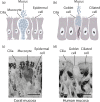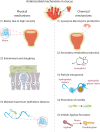Evolutionary conservation of the antimicrobial function of mucus: a first defence against infection
- PMID: 30002868
- PMCID: PMC6031612
- DOI: 10.1038/s41522-018-0057-2
Evolutionary conservation of the antimicrobial function of mucus: a first defence against infection
Abstract
Mucus layers often provide a unique and multi-functional hydrogel interface between the epithelial cells of organisms and their external environment. Mucus has exceptional properties including elasticity, changeable rheology and an ability to self-repair by re-annealing, and is therefore an ideal medium for trapping and immobilising pathogens and serving as a barrier to microbial infection. The ability to produce a functional surface mucosa was an important evolutionary step, which evolved first in the Cnidaria, which includes corals, and the Ctenophora. This allowed the exclusion of non-commensal microbes and the subsequent development of the mucus-lined digestive cavity seen in higher metazoans. The fundamental architecture of the constituent glycoprotein mucins is also evolutionarily conserved. Although an understanding of the biochemical interactions between bacteria and the mucus layer are important to the goal of developing new antimicrobial strategies, they remain relatively poorly understood. This review summarises the physicochemical properties and evolutionary importance of mucus, which make it so successful in the prevention of bacterial infection. In addition, the strategies developed by bacteria to counteract the mucus layer are also explored.
Conflict of interest statement
The authors declare no competing interests.
Figures




References
-
- Bythell JC, Wild C. Biology and ecology of coral mucus release. J. Exp. Mar. Bio. Ecol. 2011;408:88–93. doi: 10.1016/j.jembe.2011.07.028. - DOI
Publication types
LinkOut - more resources
Full Text Sources
Other Literature Sources

